Cross-Linguistic Similarity Evaluation Techniques Based on Deep Learning
Abstract
For the cross-linguistic similarity problem, a twin network model with ordered neuron long- and short-term memory neural network as a subnet is proposed. The model fuses bilingual word embeddings and encodes the representation of input sequences by ordered neuron long- and short-term memory neural networks. Based on this, the distributed semantic vector representation of the sentences is jointly constructed by using the global modelling capability of the fully connected network for higher-order semantic extraction. The final output part is the similarity of the bilingual sentences and is optimized by optimizing the parameters of each layer in the framework. Multiple experiments on the dataset show that the model achieves 81.05% accuracy, which effectively improves the accuracy of text similarity and converges faster and improves the semantic text analysis to some extent.
1. Introduction
The role of text similarity assessment in sentiment analysis, content recommendation, data mining, protection of intellectual property rights of electronic texts, and combating illegal copying and plagiarism of academic results cannot be underestimated. Since the launch of China Knowledge Network’s “Academic Misconduct Literature Detection System” [1], it has blocked the publication of articles with a high repetition rate at the source of academic paper results; CrossCheck [2], an antiplagiarism literature detection system developed by the International Publishing Links Association, has minimized the textual repetition rate of English publications. With the increased degree of cultural exchange in the world and the explosive growth of various language resources on the Internet, cross-lingual scenarios are becoming more common, leading to the increasingly urgent need for cross-lingual applications. In order to address the resulting technical barriers and achieve resource sharing across languages, academia and industry have been actively exploring cross-language natural language processing techniques [3]. Among them, cross-lingual text similarity evaluation is an important research element.
At present, the main cross-lingual text similarity algorithms are machine translation and statistical translation modelling approaches [4, 5], lexicon-based approaches [6–8], and parallel corpus-based approaches [9, 10]. The advantage of the statistical translation model-based approach for full-text machine translation is that it can be operated directly with off-the-shelf tools, and the disadvantage is that the goodness of the translation tool or model has a significant impact on the final result. The advantage of the lexicon-based approach is that it is simple and easy to operate, and the disadvantage is that it is limited by the lexicon’s coverage of words, and the effect is not apparent. The advantage of the parallel corpus-based method is that it is reliable and accurate, but the disadvantage is that the calculation is complicated, slow, and not robust. The neural network-based computation method is the mainstream cross-linguistic similarity computation method at present. The main idea is to train a neural network to map cross-lingual word embeddings [11] to the same semantic space and obtain the similarity interest between texts by calculating the distance between vectors.
Barrón et al. [12] obtained a similarity measure by calculating the proportion of n-grams overlapping in two sentences. N-grams represent consecutive semantic units of length n in a given sequence, either words or characters. Gabrilovich [13] used explicit semantic analysis of the same concept in Wikipedia to obtain a vector representation of words and then compared them. Ferrero et al. [14] used cross-lingual word vectors to compute cosine similarity to obtain similarity. Kusner et al. [15] proposed characterizing all the words of two texts as vectors. The similarity between the two texts is solved by moving all the words of one text to the minimum moving distance of the other text in the vector space; Guo et al. [16] used a bilingual dual encoder model to generate sentence embeddings, encoding both the source and target texts as sentence embeddings. An approximate nearest neighbour (ANN) search is first performed for each source text sentence to obtain multiple target sentences for each source sentence. Then, the text matching score is finally obtained by using the approximate nearest neighbor ranking of the source and target sentence matching, the absolute difference of the sentence position index, and the matching rank weighted with the normalized confidence score.
Most of the existing studies only consider a single text feature or fuse models for semantic features. To determine text similarity, we should consider multiple levels, such as word semantic information, contextual semantic information, and document information. Deep learning is usually based on a deep nonlinear network structure, which extracts information at different levels by processing the input data in layers and finally obtains the essential representation of the data. Word vector representation, sentence vector representation, and document vector representation can be obtained using deep learning techniques combined with different feature engineering methods. Therefore, this paper proposes integrating the word information and contextual semantic information into the sentence itself as its semantic representation. By combining multiple neural networks, the preprocessed sentence is used as the input of the frame to calculate the semantic similarity of sentences. On this basis, paragraphs are regarded as long sentences and used as computing units to evaluate cross-language similarity.
2. Introduction to Related Theories
2.1. Word Vectors
Early work considered words as individual atomic symbols and used one-hot representation to represent words as high-dimensional sparse vectors, but this suffers from “dimensional catastrophe” and “lexical divide”. In order to represent the similarities and differences between words, researchers have proposed distributed representations of words, also known as word vectors, which represent words as low-dimensional dense vectors and thus measure the semantic relationships between words with the help of the distance between vectors.
Early work used singular value decomposition (SVD) to obtain word distribution representations. The basic idea is that if two words frequently appear in the same document, their semantic relationships will be similar to each other. Specifically, we first accumulate the frequency of word cooccurrence in documents from the corpus, construct the cooccurrence matrix (M), and then decompose M into singular value decomposition, where each row of U is the vector representation of the corresponding word. Although this method can obtain partial semantic or structural information, there are many problems, such as the dimensionality of the matrix being too huge and very sparse and the complexity of SVD being O(n4), resulting in a very time-consuming training time. Also, if new words are added, the dimensionality of the matrix will change frequently and requires retraining.
Currently, there has been much success with iteration-based training approaches, which do not directly perform statistics and then computation from massive datasets, but rather build iterative models to learn predictions. Specifically, word vectors are used as model parameters, and the model is trained by optimizing a specific objective. During the optimization process, errors are evaluated to update the parameters so that the learned parameters can be used for language models, which is a fundamental problem in natural language processing. The NNLM model is shown in Figure 1.
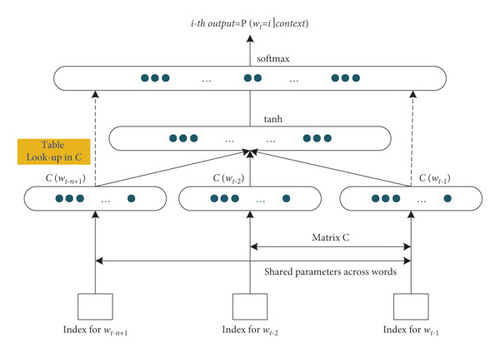
- (1)
First is a linear embedding layer. It maps the input N-1 one-hot word vectors (distributed vectors) to N-1 distributed word vectors through a shared D × V matrix C, where V is the size of the dictionary and D is the dimension of the embedding vector (a priori parameters). VThe C matrix stores the word vector to be learned.
- (2)
The second part consists of a tanh hidden layer and a softmax output layer to form a simple forward feedback network. This part maps the output N − 1 word vector to a probability distribution vector of length V, estimating the conditional probability of words in the dictionary in the input context.
2.2. Semantic Similarity
The connection between the concepts that computer language corresponds to in the real world is represented by things and the meanings these senses have, the interpretation and logical representation of something tangible in the data domain. For computer science, semantics is the user’s interpretation of a computer representation (i.e., a symbol) used to describe the real world; that is, the way the user uses it to relate the symbolic representation of the computer to the real world.
There are two main methods to calculate the semantic similarity of words; one is to organize the concepts of related words in a tree structure to calculate; the other is mainly through the information of word contexts, using statistical modelling methods.
2.3. Recurrent Neural Network
RNN is a class of recurrent neural networks that takes sequence data as input, recurses in the direction of sequence evolution, and all nodes are connected in a chain-like manner. RNN models can model text using contextual sequence relationships, thus solving the fixed window problem of feedforward neural network models (Figure 2). This is closer to the human brain’s model of text processing than the feedforward neural network model, and using this correlation can improve the predictive power of the model.
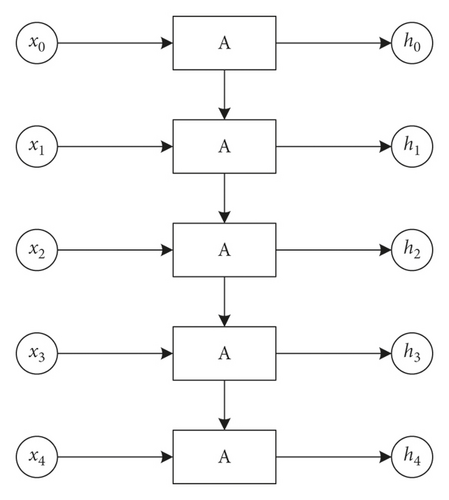
However, the recurrent neural network itself also has a certain degree of limitation; the degree of learning for relatively distant sequence information will produce a longer distance dependence. The emergence of a long short-term memory neural network (LSTM) can better solve the dependence on the learning of relatively distant sequence information in recurrent neural networks. The LSTM structure is shown in Figure 3.
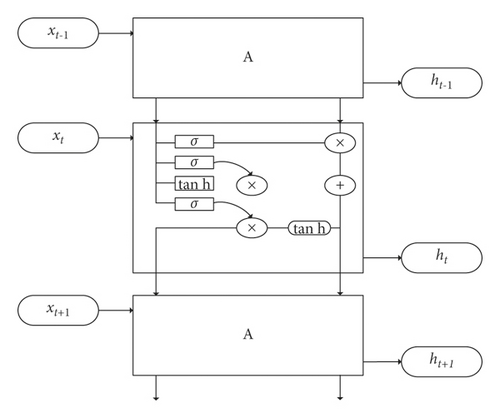
3. Deep Learning Module
For the previous models considering only a single text feature or only for semantic features, this paper draws on the idea of literature [17] to form a twin network with On-LSTM as a subnet. Shared parameter configuration and connection weights are used to save network training time and also to avoid overfitting. The problem of long-distance dependence arises due to how the recurrent neural network learns sequence information at relatively long distances with the continuous input of relevant sequence information. The problem of perceptual weakening may arise for some information on the previous longer sequence information, which in turn can lead to gradient explosion and gradient dispersion.
In this paper, On-LSTM integrates the hierarchical structure (tree structure) of neurons into the LSTM after specific ordering, thus allowing the long short-term memory neural network to learn the hierarchical structure information in text sentences. In turn, the deep feature representation of the textual information and the semantic relationships encoded between each sentence is obtained, and On-LSTM allows the recurrent neural network model to perform tree synthesis without destroying its sequence representation. Subsequently, a fully connected network is used for higher-order semantic extraction, and the output is computed as the similarity result using a power finger function. The specific structure is shown in Figure 4.
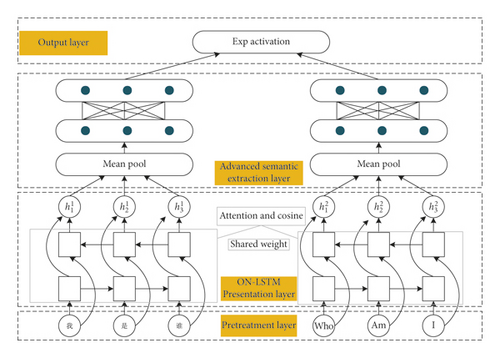
The role of the On-LSTM representation layer is mainly to encode the input vectors from the preprocessing layer and map Chinese and English to the same semantic space as the input features of the higher-order semantic extraction layer. In this paper, we mainly use two-way On-LSTM for semantic encoding and combine the attention mechanism and cosine similarity for improvement. On-LSTM is the subnet structure for semantic representation and similarity calculation of bilingual sentences. An on-LSTM neural network can utilize the neuronal order information in the neural network by forming an ordered structure to represent some specific information structure of sequence information by some changes of disordered neurons. It can automatically learn the hierarchical structure information of the sentence, extract deep feature information from the contextual input information, and better learn the connection between the contexts.
In this paper, the whole framework is divided into four layers: the preprocessing layer, the On-LSTM representation layer, the higher-order semantic extraction layer, and the output layer. A twin neural network (Siamese network) is used as a weight-sharing network framework to fuse bilingual word embeddings and encode the input sequence representation by ordered neuron LSTM. Based on this, the distributed semantic vector representation of the sentences is jointly constructed using the global modelling capability of the fully connected network for higher-order semantic extraction. The final output part is the similarity of bilingual sentences, and the loss function optimally selects the parameters of each layer in the framework.
3.1. Data Preprocessing Layer
The processing layer can be considered the input source for the entire framework. The data preprocessing layer maps the input sentences as a list of word vectors as input to the implicit layer of the presentation layer On-LSTM. Commonly used preprocessing steps include word expansion and division, word stemming, POS, and destaying words. Only word splitting is required for semantic sentence modelling, and no lexical annotation is required.
3.2. Semantic Encoding
The role of the On-LSTM representation layer is mainly to encode the input vectors from the preprocessing layer and map Chinese and English to the same semantic space as the input features of the higher-order semantic extraction layer. In this paper, we mainly use two-way On-LSTM for semantic encoding and combine the attention mechanism and cosine similarity for improvement. On-LSTM is the subnet structure for semantic representation and similarity calculation of bilingual sentences. An on-LSTM neural network can utilize the neuronal order information in the neural network by forming an ordered structure to represent some specific information structure of sequence information by some changes of disordered neurons. It can automatically learn the hierarchical structure information of the sentence, extract deep feature information from the contextual input information, and better learn the connection between the contexts.
3.3. Fusion Attention Mechanism and Cosine Similarity
The attention mechanism can make the model pay more attention to the representation of some words when expressing the semantic information of the text through specific computational methods. The attention mechanism assigns different weights ai to each word, and the magnitude of ai can reflect the importance of the word. This paper uses the context-aware attention mechanism proposed by Yang et al. [18]. This attention mechanism introduces a context vector, which helps identify entity words, and ai is randomly initialized and can be learned together with the weights of other attention layers.
3.4. Higher-Order Semantic Extraction
3.5. Output of Similarity Results
The vector representation of the two sentences is obtained via the fully connected layer, and then, the difference is measured by the exponential function, which takes values in the range (0, 1] since the power order of the exponential function is the negative of the first-order parametrization. The biggest highlight of this formula is using the L1 parametrization to measure the difference of the obtained sentence vectors. Since the final output is the difference between the two-sentence vectors and can be viewed as a vector, the above function can be seen as the activation function for the final output.
4. Experiment and Analysis
The relevant hardware environment for the experiments is Windows 10 (64 bit), Intel (R) Core (TM) i7-6700HQ CPU @ 2.60 GHz processor, and 16.00 GB RAM. The development platform uses IntelliJ IDEA and PyCharm. The development languages are Python 3.6 and Java.
By comparing the algorithm of this paper with CNN, LSTM, and BiLSTM-CNN, the results are shown in Table 1.
| Model type | Accuracy | F1-score |
|---|---|---|
| CNN | 77.10 | 66.47 |
| LSTM | 75.02 | 65.31 |
| BiLSTM-CNN | 79.36 | 74.45 |
| Algorithm of this paper | 81.05 | 75.26 |
The framework proposed in this paper generally outperforms the other algorithms in computing text similarity. The accuracy and F1-score of the network model in this paper reach 81.05% and 75.26%, respectively, higher than the other four models. BiLSTM-CNN outperforms the single model due to the hybrid model. In this paper, the twin network composed of ON-LSTM automatically learns the hierarchical structure information better to represent the deep semantic information of the text, and the experimental results are also optimal. The results are shown in Figure 5.
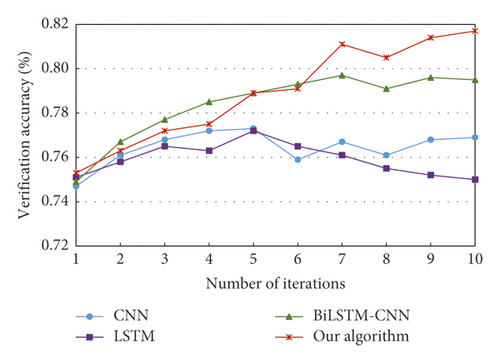
The changing trend is to increase and then stabilize, with the CNN and LSTM models having the most similar rates of change compared to the other two groups of models. For the hybrid model of CNN and LSTM, BiLSTM-CNN outperforms any single model of both. The proposed text similarity model shows an increasing and then smooth trend, which is better than the other four deep learning models and has better performance and higher accuracy in text feature extraction. The results are shown in Figure 6.
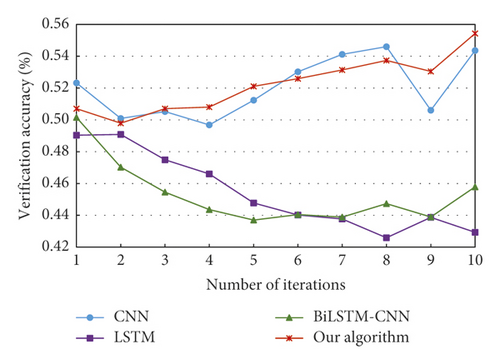
The fluctuation of the CNN model is the most unstable, and the overall fluctuation of this model is less compared with the other four groups of deep learning models. The trend of variation decreases and becomes stable. The short text similarity model based on ordered neuron LSTM has the advantages of fast convergence and high accuracy.
In order to measure the convergence speed among the five groups of deep learning models, the time cost of each iteration, that is, the time cost of the model to complete one training, is calculated. Figure 7 shows the trend of the time cost of different deep learning models with the number of iterations. Except for the CNN model, this model outperforms the other models in terms of time consumption, and the time cost is the smallest, which indicates that the short text similarity model based on ordered neuron LSTM proposed in this paper has the advantage of fast convergence speed.
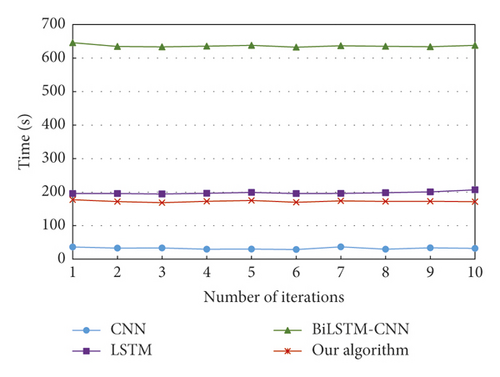
5. Conclusion
In this paper, we propose a twin network structure model using On-LSTM as a subnet, mapping Chinese and English to the same semantic space, using ON-LSTM to automatically learn the hierarchical structure information better to represent the deep semantic information of the text, combining with the overall semantic information representation, and finally calculating the semantic similarity of the text through the matching layer. Several sets of comparison experiments show that the model in this paper has better improvement than other comparable models in index analysis and can better calculate the text similarity, which is feasible and effective.
Conflicts of Interest
The author declares that there are no conflicts of interest.
Acknowledgments
This work was supported by the Hebei Vocational University of Technology and Engineering.
Open Research
Data Availability
The data used to support the findings of this study are available from the corresponding author upon request.




